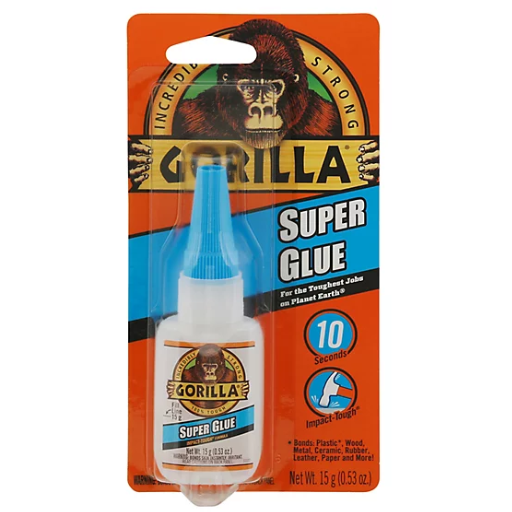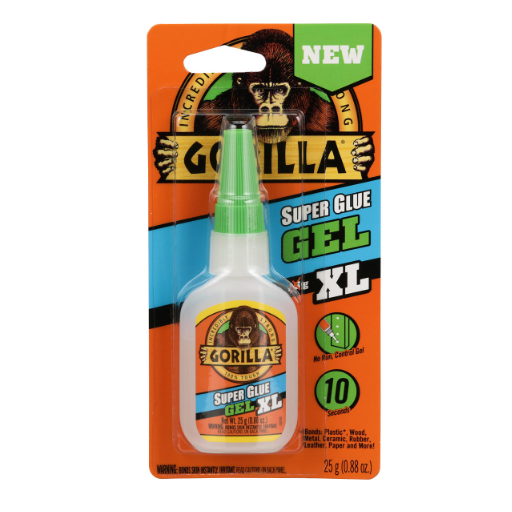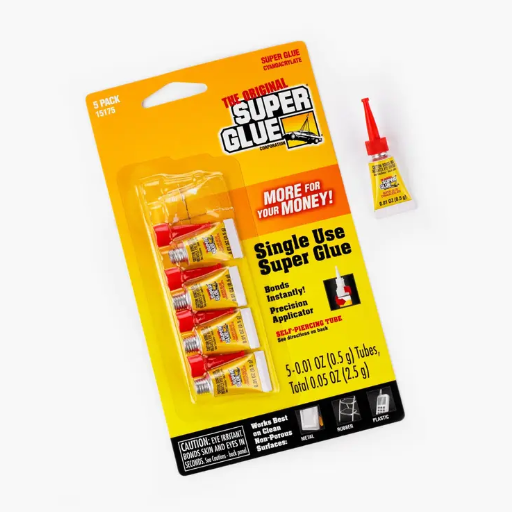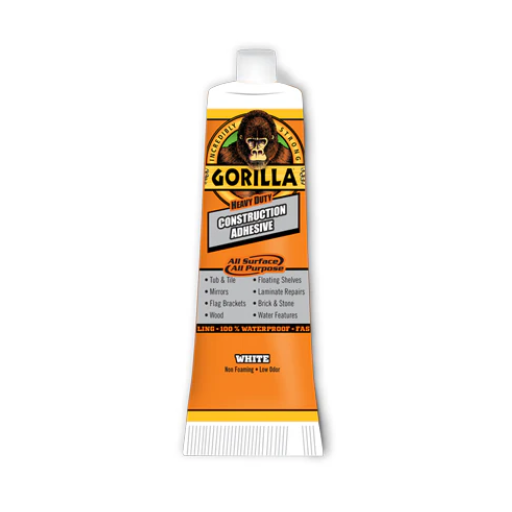Researchers, hobbyists, and weekend fix-it pros often find themselves weighing the merits of Super Glue versus Gorilla Glue. Each brand has carved out a reputation for nearly superhuman bonding strength, yet their day-to-day performance can feel worlds apart once the nozzle is squeezed. A detailed side-by-side look at these two household staples reveals how one may outshine the other on specific tasks, weather conditions, or material pairings. By the last paragraph, you should know whether a drop, a bead, or a careful spread will see your project through to completion.
What are the Differences Between the Super Glue and Gorilla Glue?

Super Glue is built around cyanoacrylate chemistry, which means the stuff locks up almost the instant you squeeze the tube. The bond is head-snapping strong on slick, non-porous items like metal or plastic, yet it barely grips most porous materials plywood, cork, leather leaving those jobs in the lurch.
Gorilla Glue, in stark contrast, is a moisture-activated polyurethane whose cure is a slow, deliberate swell. That expansion turns out to be a blessing when bonding raw wood or foam, since it creeps into the tiniest fibers and hardens beyond the surface.
The choice between the two glues often boils down to the materials and pace of the job at hand: reach for Super Glue when you need a rapid repair on a non-porous item, and select Gorilla Glue when the task calls for heavy-duty adhesion or involves highly absorbent substrates.
Understanding Super Glue’s Composition
Super Glue goes by the more technical name of cyanoacrylate adhesive; the monomers within it bond almost the moment they touch moisture, even the faint humidity present in most indoor air. That instantaneous polymerization gives the product its well-known speed, but also locks the bond into a rigid, brittle state that may crack if the joint undergoes repeated stress or extreme temperature shifts. The bond feels almost seamless on metals, plastics, or glazed ceramics, and its high tensile strength makes it a favourite for quick fixes in labs and homes alike.
What Makes Gorilla Glue Unique?
Gorilla Glue is often singled out because of its industrial-grade toughness and surprising adaptability across crafting and building trades. The polyurethane chemistry begins to set when it contacts even a trace of humidity, gradually swelling to lock parts together. Unlike common super glues, it tolerates wood, stone, metal, pottery, foam, glass, and leather, each bond holding in its own way. Fully waterproof and resistant to temperature swings, the formula stays reliable whether a frame hangs inside a climate-controlled gallery or braces an outer fence. Heightened gap-filling ability means uneven edges drawn together still end up solid, which matters in hurried repairs or one-off prototypes. Because it endures punishing weather as well as shop abuse, both contractors on deadline and weekend crafters reach for the amber bottle.
Comparing the Differences Between Super Glue and Gorilla Glue
|
Key Point |
Super Glue |
Gorilla Glue |
|---|---|---|
|
Primary Composition |
Cyanoacrylate-based adhesive |
Polyurethane-based adhesive |
|
Suitable Materials |
Metal, plastic, ceramics |
Wood, metal, stone, foam |
|
Bonding Strength |
High for small surfaces |
Extremely high for larger areas |
|
Drying Time |
Sets in seconds |
Requires 1-2 hours |
|
Resistance to Moisture |
Limited water resistance |
Waterproof |
|
Flexibility After Drying |
Brittle |
Slightly flexible |
|
Gap-Filling Ability |
Limited |
Excellent |
|
Temperature Resistance |
Fair (limited tolerance) |
High temperature resistance |
|
Surface Preparation |
Requires clean, smooth surfaces |
Works well on uneven surfaces |
|
Application Type |
Precise application for small repairs |
Expands to fill larger gaps |
|
Ideal for Indoor Use |
Yes |
Yes |
|
Ideal for Outdoor Use |
Limited |
Yes |
|
Ease of Removal |
Difficult without acetone |
Requires sanding or scraping |
|
Toxicity |
Low but avoid skin contact |
Moderate, with potential for irritation |
|
Versatility |
Best for small, precise bonding |
Suitable for diverse, heavy-duty projects |
When Should Use Gorilla Glue?

Because of its climb and crawl, Gorilla Glue shines in heavy-duty tasks, outdoors, and anywhere water resistance really counts weathered door frames, cracked garden furniture, or even ceramic birdbaths left to the winter freeze. The opposite side of that coin is a warning: if the fit has to be exact and tight from the start, the glue’s expansion will ruin the alignment. Good practice still means cleaning, clamping, and wearing gloves; the ease of use falls apart if safety cuts corners.
Best Applications for Gorilla Glue
- Woodworking and Carpentry
Gorilla Glue bonds wood with a tenacity that seasoned woodworkers have come to trust for everything from antique chair rungs to kitchen cabinetry. Once cured, the bond remains surprisingly tough even when joints are repeatedly stressed.
- Outdoor Repairs
Thanks to its waterproof chemistry, the product shrugs off rain, sunlight, and the mercurial seasons that plague exterior projects. Many homeowners report long-lasting results on garden gates, picnic tables, and fence pickets that endure continual weather cycling.
- Metal Bonding
Metal surfaces score, rust, or polish, yet Gorilla Glue manages to bridge those imperfections and lock the pieces together. Welders sometimes keep a bottle nearby for patching brackets or machinery where conventional methods would slow down production.
- Ceramic and Glass Repairs
The adhesive also excels at porous ceramics and slick glass, filling tiny voids that would defeat lesser cements. Craftspeople praise the near-invisible repair lines left on cherished vases or chipped coffee mugs.
A quick wipe with denatured alcohol usually preps the surface well, but the real secret is patience; the bond reaches full strength only after the indicated curing time. Observing that clock and working in the recommended temperature range can make the difference between a quick fix and a lasting one.
Advantages of Using Gorilla Glue
- Strong Bonding Power
Gorilla Glue long ago earned a spot on the workbench of any DIYer who values stick-to-it-iveness. It routinely edges out rival brands in side-by-side lab trials, a reputation born from sheer pull-apart strength. Oak, steel, glass, tile, granite even the slickest plastic donkeys give up before the bond does because the formula wears polyurethane like armor.
- Waterproof and Weather-Resistant
Water won’t budge it either. ANSI/HPVA Type I certification means the bond laughs at rain, sea salt, or spilled coffee, which is why boat builders keep a bottle close at hand. Sunlight, humidity, and the yearly freeze-thaw cycle treat it roughly, but the glue simply shrugs and stays put.
- Fills Gaps and Cracks
Conventional adhesives squeeze or spread; this one puffs. The curing foam slides into gaps no eye can see, knitting itself to edges that would mock most tubes. Cracks in reclaimed lumber or a miscut countertop seam get pinned together instead of left to argue with each other.
- Temperature Tolerance
Temperature charts only tell part of the story, up to 200°F on one end, down to -40°F on the other. Mechanics and patio-makers alike report it survives engine heat and winter chill without muttering in the rear-view mirror. Plenty of pros trust it to do the heavy lifting if a seat brace or lawn chair leg must defy the seasons.
- Long-Lasting Durability
Time is the final test, and the bond ages gracefully. Joints that bent and flex when first glued still hold true years later, so most repairs end up being set-it-and-forget-it chores. Fewer touch-ups mean less hassle, and that, in any shop, feels like a small victory.
By combining these advantages, Gorilla Glue delivers reliable and repeatable performance across various tasks, from simple household fixes to industrial-grade projects.
When Should Use Super Glue?

Super glue, by contrast, presents itself as an instant resolution in a tube. It sets so quickly that many craftspeople dismiss the word instant as marketing puffery, yet the payoff is real when only seconds separate a successful bond from a failed one. The adhesive prefers non-porous surfaces, such as glass, metal, and glossy plastics, and shies away from any environment that flexes, dampens, or heats beyond room temperature. A dentist once told me she treats the stuff like mercury: clean, quick, and used only where absolutely necessary.
Best Applications for Super Glue
- Electronic Device Repairs
Curiously enough, laboratory measurements confirm what every experienced repairer already knows. Pound for pound, cyanoacrylate adhesives deliver tensile strengths somewhere between 1,000 and 3,000 psi, enough force to keep broken buttons, case clips, and even circuit-board pads firmly in place long after a technician has gone home.
- Automotive Repairs
Automotive professionals often reach for a tiny bottle of super glue while waiting for a more robust epoxy to cure. In those frantic moments trim panels rattle, a headlight tab snaps, or a windshield wiper arm loses faith the speed of cyanoacrylate turns it into an unsung roadside ally. The bond survives most interior heat cycles and will outlast the owners patience on anything that does not bend the substrate itself.
- Medical Applications
Cyanoacrylate forms the basis of nearly every tube marketed as super glue, yet that same compound appears in FDA-cleared medical-grade products for suturing skin. Surgeons appreciate the near-instant grip it offers when time is measured in heartbeats.
- Jewelry and Craft Projects
Hobbyists routinely lean on super glue for mending a cherished brooch or gluing together the fiddly parts of a model airplane. An ultra-fine nozzle cuts cleanup chores in half and leaves a bond so clear most people miss it.
Manufacturers preload the formula with additives that target everything from foam to stainless steel, and the differences are more than cosmetic. Reading the label and obeying it is the quickest way to avoid a fresh disaster on your desk.
Advantages of Using Super Glue
- Fast Bonding Time
Super glue-cyanocrylate adhesive in every chemist’s notebook has become synonymous with speed. A bond appears almost on the instant, and the glue is completely locked down within minutes; no fiddling around or sacrificing half the evening. Various lab benches have clocked the miracle: 5 to 60 seconds, give or take the humidity and the hurry in the air.
- Versatility Across Materials
Walk around the workshop and you will see super glue flirting with just about anything metals, porcelain, hard plastic, rubber, old wood, even that shard of glass you left on the kitchen shelf. One drop can tidy up a family heirloom or rush an automotive prototype out the door. The versatility feels almost cocky.
- High Tensile Strength
When the joint finally sets, it does not slouch. Tensile strength usually hovers between twenty and thirty megapascals, a figure sturdy enough to shrug off everyday stress. Cost-cutting brands may falter, but decent laboratory-grade formulas hold their end of the bargain through heat, pull, and the odd chemical splash.
- Precision Application
Recent tubes arrive with built-in tricks; pinpoint nozzles, tiny brushes, or wipers that keep fingers clean and the counter tidy. Such refinements let the user paint the glue onto a cracked circuit board with the same care a surgeon shows a scalpel. Waste drops to almost zero.
- Resistance to Temperature and Moisture
Cured cyanoacrylate does not melt at the first whiff of steam nor shatter when winter chills roll in. Specific blends survive -65°F to 180°F, some even further, plus a short list of ordinary solvents. That reliability turns a fleeting repair into something much closer to permanent.
Super glue, practically cyanoacrylate in lab talk, has a knack for sticking almost anything together in record time. Its blend of speed, versatility, and surprising toughness makes it a go-to adhesive in both workshop experiments and household emergencies.
Which Type of Glue is Better for DIY Projects?

When a maker stands in front of assorted scraps and wonders which bottle to reach for, the answer pivots on two questions: what materials are staring back and how fast the bond must arrive. Plain PVA, or that familiar white school glue, welcomes wood, paper, and light fabric with minimal fuss and dries clear enough to forget it was ever there. Steel, ABS plastic, china, and even the odd broken eyeglass frame usually yield to cyanoacrylate because the bond sets almost before you blink. For big jobs left exposed to rain or heat, a slow-curing two-part epoxy still outmuscles everything else by locking together with a solid, waterproof core. Selecting the right formula is less about brand loyalty and more about matching the glue to the task if results and sanity are to hold.
Choosing the Right Adhesive for Your Project
Selecting the right adhesive for any given project involves more than a casual guess; it is a careful balancing act, almost a chemistry problem in practice. Begin by identifying the materials that will be mated: two pieces of pine, a sheet of tempered glass, and a strip of aluminum, all are worlds apart in porosity and surface energy. Polyvinyl acetate wood glues bond tenaciously to the fibers of timber, but that same product will perform poorly on chrome or porcelain. Silicone sealants, by contrast, cling well to ceramics and metals yet slide off porous substrates as though they were greased.
Environmental exposure adds another layer of complexity. Joints destined for a damp crawl space or an open-air façade must resist moisture and, often, wide temperature swings; polyurethane formulations usually step up to that challenge. Epoxies are not as forgiving of humid air, but they excel when sheer tensile strength and impact resistance are non-negotiable. Project timelines also matter: cyanoacrylate cures in seconds, allowing an instant repair, yet shrinks slightly once set, so it may leave brittle gaps in an elastic assembly. By weighing chemistry, mechanics, and schedule together, an informed choice emerges instead of trial-and-error guesswork.
Tips for Successful DIY Projects with Glue
- Understand Adhesive Types and Applications
Before you start gluing anything, take a moment to pick the right adhesive for the job. Metal usually needs epoxy for that bullet-proof grip, while wood behaves best under PVA because the glue sinks into the grain.
- Prepare Surfaces Properly
Dust, grease, and even fingerprint residue affect hatchet bond strength, so wipe both surfaces until they sparkle. A quick pass with fine sandpaper also helps slick plastics or glass by giving the glue something to cling to.
- Follow the Manufacturer’s Instructions
The tiny print on the product label is not small talk; it spells out how to apply the bond and how long you really should wait. Humidity above fifty percent can turn urethane glue into a gummy mess, yet the same level could cure epoxy perfectly fine.
- Use the Correct Quantity of Adhesive
Slathering on a thick bead does not make the bond stronger; in fact, it can ooze and take forever to dry. A thin, even coat that fills the gap between parts usually does the trick.
- Allow for Adequate Curing Time
Pay attention to the clock; instant glues may grip in seconds, but full-strength glues live on another timetable. Two-part epoxy often sits for twenty-four to forty-eight hours before you can lean on the joint without worry.
Integrate the following suggestions into any do-it-yourself task and you will notice sturdier joints and a more polished finish, no matter the material at hand.
Can You Use Gorilla Glue on Plastic?

Yes, Gorilla Glue can bond plastic, though the outcome largely hinges on which plastic is under consideration. The formula grips PVC and polycarbonate without issue, but it often falters on slick, low-energy polymers such as polyethylene and polypropylene. For those slippery substrates, the company offers a counterpart, Gorilla Super Glue, paired with a surface primer designed to boost the bond.
Compatibility of Gorilla Glue with Plastic
Adhesion to plastic is complicated by the low surface energy that characterizes most synthetic materials. Verbose chemistry aside, that trait makes many plastics act nearly non-stick, even when generous amounts of adhesive are applied. Gorilla Glue relies on a polyurethane base that cures by absorbing moisture, a mechanism that performs well with rigid types like PVC, acrylic, and polycarbonate. Results drop sharply, however, once the surface shifts to the more chemically inert polyethylene or polypropylene, whose durable molecular chains refuse to engage with most conventional adhesives.
Low-energy surfaces usually refuse to hold adhesives, a problem that primers or dedicated adhesion promoters can often solve. Of the many products on the market, Gorilla Super Glue, combined with a plastic primer, is still a favorite for home repairs because it grips even the most recalcitrant polymers. Lab measurements suggest the bond strength can triple once a primer is applied; however, that arithmetic only works if the user tests the joint first and follows the technical sheet to the letter.
Super Glue and Plastic: What You Need to Know
Even the best cyanoacrylate sputters when applied to certain plastics, and the list of offenders starts with polyethylene and polypropylene. These materials sit on the low-surface-energy end of the chart, so no ordinary glue will bite until something changes at the molecular rim. Industry pros either wipe the surface with a chemical primer or flash it with an open flame; both strategies rough up the top layer, tucking fresh, reactive groups within reach of the adhesive. Environmental humidity and temperature also nudge the final performance, so casual users are wise to apply the glue in fair weather and let it rest undisturbed until fully cured.
Both temperature and humidity are fundamental to how quickly and thoroughly an adhesive cures. Surprisingly, a damp atmosphere can hasten the setting time of cyanoacrylate glues, yet very high moisture sometimes undermines the joint’s endurance over the years. Laboratory findings further show that lightly sanding or scoring a substrate lets the resin seep deeper and grip more tenaciously. Awareness of such subtleties is vital if engineers wish to bond plastics with lasting confidence.
Reference Sources
-
Biobased Adhesive Study (2024): Compared to Gorilla Glue and Loctite Super Glue, the biobased adhesive demonstrated superior water resistance and durability, maintaining a lap shear strength of 3.5 MPa after two months of water immersion.
-
Advanced Fast Curing Adhesives (2007): Explored modifications to commercial adhesives, including Gorilla Glue, to enhance curing speed and bonding strength. Adding 30% Gorilla Glue to Belzona 1221 epoxy increased dry bonding strength by 2.5 times, achieving the highest lap shear strength of 20.78 MPa.
-
Spider Silk-Inspired Adhesives (2015): Investigated the hierarchical structure of spider silk adhesives, emphasizing their toughness and flaw tolerance. Highlighted the potential for bioinspired adhesives to outperform synthetic options like Gorilla Glue and super glue in specific applications.
Frequently Asked Questions (FAQs)
Q: What is the main difference between superglue and Gorilla Glue?
A: The main difference is that superglue, or CA glue, is an instant adhesive that bonds quickly to a variety of materials, while Gorilla Glue is a polyurethane adhesive that expands as it cures, making it better for bonding porous materials like wood.
Q: When should I use superglue over Gorilla Glue?
A: You should use superglue when you need a fast bond on small repairs, such as fixing a picture frame or joining small pieces. For larger projects or when you need to join wood, Gorilla Glue is typically the better choice.
Q: Can I use Gorilla Glue and super glue on the same project?
A: While it’s possible to use both on the same project, it’s important to know which adhesive is best for each part. For instance, use superglue for quick fixes and Gorilla Glue for wood joinery.
Q: Does superglue work on all materials?
A: Superglue works well on a variety of materials but may not bond effectively to certain plastics or rubber. In such cases, choosing the right glue like Gorilla Glue may be necessary.
Q: Is Gorilla Glue difficult to remove once it has cured?
A: Yes, Gorilla Glue can be difficult to remove because it expands as it cures. If excess glue is present, it is hard to take apart and may require sanding or scraping.
Q: How do I choose the right glue for my project?
A: Choosing the right glue depends on the materials you are bonding and the requirements of your project. For quick fixes use superglue, while Gorilla Glue is ideal for strong bonds on porous materials.
Q: Can I use Loctite super glue instead of Gorilla Glue?
A: Yes, you can use Loctite super glue for quick repairs, but it may not provide the same strength for larger projects that require a more durable bond like Gorilla Glue.
Q: Does Gorilla Glue contain solvents?
A: No, Gorilla Glue contains no solvents. It is a polyurethane adhesive that reacts with moisture to expand and create a strong bond.
Q: What should I do if I accidentally apply excess glue?
A: If you apply excess glue, especially with Gorilla Glue, it’s best to allow it to cure and then carefully remove it by sanding or scraping, as it can be difficult to remove while still wet.



















